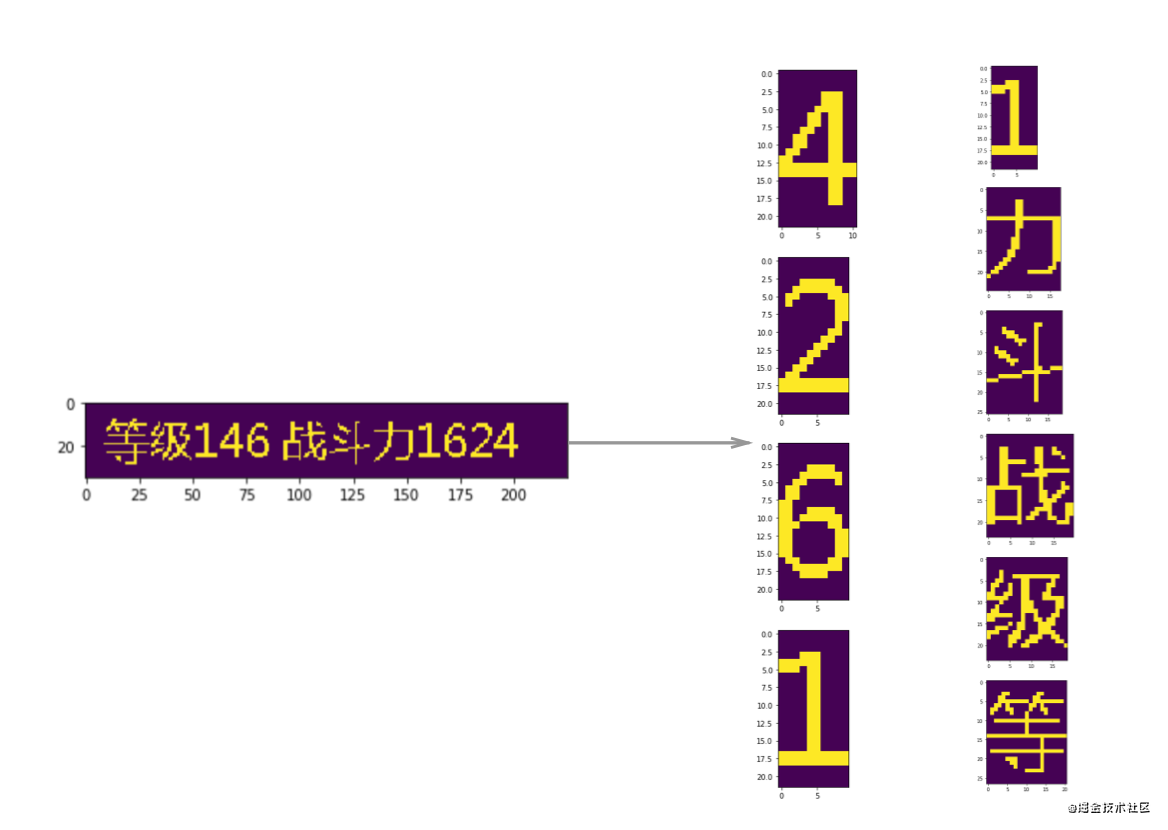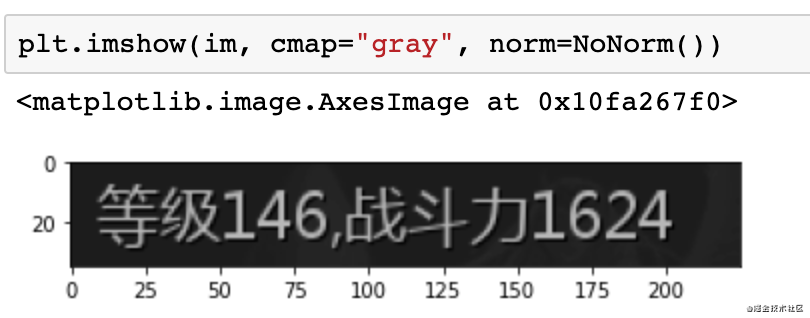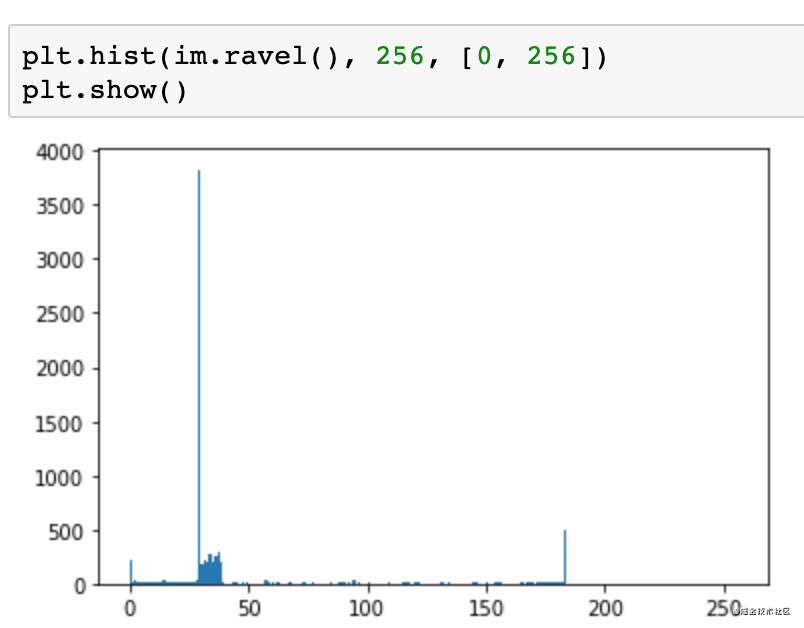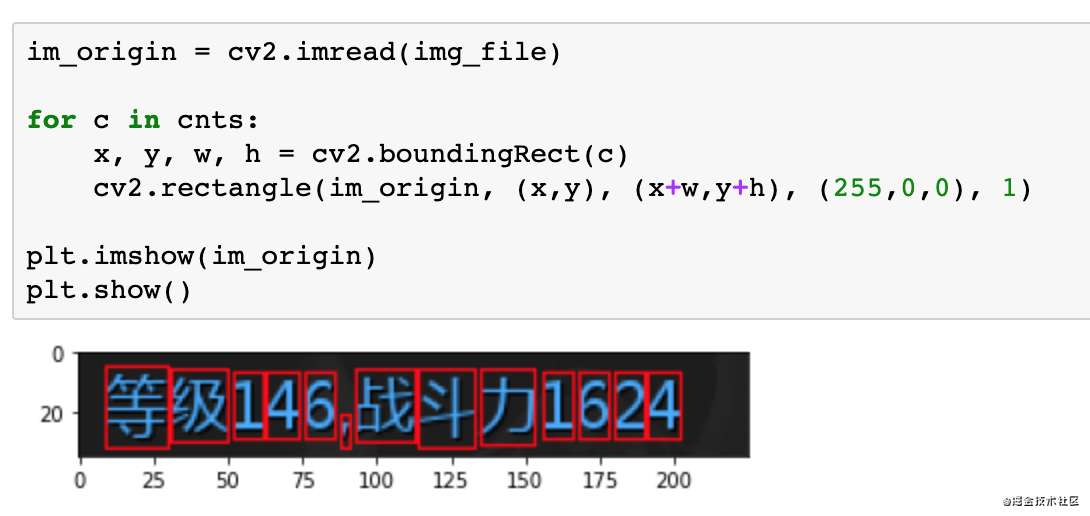Python 官方文档:入门教程 => 点击学习
小编给大家分享一下python怎么做一个识别率百分百的OCR,相信大部分人都还不怎么了解,因此分享这篇文章给大家参考一下,希望大家阅读完这篇文章后大有收获,下面让我们一起去了解一下吧!写在前面当然这里说的百分百可能有点夸张,但其实想象一下,
小编给大家分享一下python怎么做一个识别率百分百的OCR,相信大部分人都还不怎么了解,因此分享这篇文章给大家参考一下,希望大家阅读完这篇文章后大有收获,下面让我们一起去了解一下吧!
当然这里说的百分百可能有点夸张,但其实想象一下,游戏里面的某个窗口的字符就是那种样子,不会变化的。而且识别的字符可能也不需要太多。中文有大几千个常用字,还有各种符号,其实都不需要。
这里针对的场景很简单,主要是有以下几点:
识别的字符不多:只要识别几十个常用字符即可,比如说26个字母,数字,还有一些中文。
背景统一,字体一致:我们不是做验证码识别,我们要识别的字符都是清晰可见的。
字符和背景易分割:一般来说就是对图片灰度化之后,黑底白字或者白底黑字这种。
opencv-python
环境主要是以下的库:
pip install opencv-pythonpip install imutilspip install matplotlib首先看下图片的灰度图。

二值化,将灰度转换为只有黑白两种颜色。

图像膨胀,因为我们要通过找轮廓算法找到每个字符的轮廓然后分割,如果是字符还好,中文有很多左右偏旁,三点水这种无法将一个整体进行分割,这里通过膨胀将中文都黏在一起。

找轮廓。

外接矩形。我们需要的字符是一个矩形框,而不是无规则的。

过滤字符,这里比如说标点符号对我来说没用,我通过矩形框大小把它过滤掉。

字符分割,根据矩形框分割字符。

构造数据集,每一类基本上放一两张图片就可以。

向量搜索+生成结果,根据数据集的图片,进行向量搜索得到识别的标签。然后根据图片分割的位置,对识别结果进行排序。
首先先读取待识别的图片。
import cv2import numpy as npfrom matplotlib import pyplot as pltfrom matplotlib.colors import NoNORMimport imutilsfrom PIL import Imageimg_file = "test.png"im = cv2.imread(img_file, 0)使用matplotlib画图结果如下:

在进行二值化之前,首先进行灰度分析。

灰度值是在0到255之间,0代表黑色,255代表白色。可以看到这里背景色偏黑的,基本集中在灰度值30,40附近。而字符偏白,大概在180灰度这里。
这里选择100作为分割的阈值。
thresh = cv2.threshold(im, 100, 255, cv2.THRESH_BINARY)[1]2值化后效果如下:

接下来进行一个图像的纵向膨胀,选择一个膨胀的维度,这里选择的是7。
kernel = np.ones((7,1),np.uint8) dilation = cv2.dilate(thresh, kernel, iterations=1)
接下来调用opencv找一下轮廓,
# 找轮廓cnts = cv2.findContours(dilation.copy(), cv2.RETR_EXTERNAL, cv2.CHaiN_APPROX_SIMPLE)cnts = imutils.grab_contours(cnts)接下来我们再读取一下原图,绘制轮廓看下轮廓的样子。

对于轮廓我们可以做外接矩形,这里可以看下外接矩形的效果。

这里过滤字符的原理其实就是将轮廓内的颜色填充成黑色。下面的代码是将高度小于15的轮廓填充成黑色。
for i, c in enumerate(cnts): x, y, w, h = cv2.boundingRect(c) if (h < 15): cv2.fillPoly(thresh, pts=[c], color=(0))填充后可以看到标点符号就没了。

因为图像是个矩阵,最后字符分割就是使用切片进行分割。
for c in cnts: x, y, w, h = cv2.boundingRect(c) if (h < 15): continue cropImg = thresh[y:y+h, x:x+w] plt.imshow(cropImg) plt.show()最后我们创建数据集进行标注,就是把上面的都串起来,然后将分割后的图片保存到文件夹里,并且完成标注。
import cv2import numpy as npimport imutilsfrom matplotlib import pyplot as pltimport uuiddef split_letters(im): # 2值化 thresh = cv2.threshold(im, 100, 255, cv2.THRESH_BINARY)[1] # 纵向膨胀 kernel = np.ones((7, 1), np.uint8) dilation = cv2.dilate(thresh, kernel, iterations=1) # 找轮廓 cnts = cv2.findContours(dilation.copy(), cv2.RETR_EXTERNAL, cv2.CHAIN_APPROX_SIMPLE) cnts = imutils.grab_contours(cnts) # 过滤太小的 for i, c in enumerate(cnts): x, y, w, h = cv2.boundingRect(c) if h < 15: cv2.fillPoly(thresh, pts=[c], color=(0)) # 分割 char_list = [] for c in cnts: x, y, w, h = cv2.boundingRect(c) if h < 15: continue cropImg = thresh[y:y + h, x:x + w] char_list.append((x, cropImg)) return char_listfor i in range(1, 10): im = cv2.imread(f"test{i}.png", 0) for ch in split_letters(im): print(ch[0]) filename = f"ocr_datas/{str(uuid.uuid4())}.png" cv2.imwrite(filename, ch[1])向量搜索其实就是个最近邻搜索的问题,我们可以使用sklearn中的KNeighborsClassifier。
训练模型代码如下:
import osimport numpy as npfrom sklearn.neighbors import KNeighborsClassifierimport cv2import pickleimport JSONmax_height = 30max_width = 30def make_im_template(im): template = np.zeros((max_height, max_width)) offset_height = int((max_height - im.shape[0]) / 2) offset_width = int((max_width - im.shape[1]) / 2) template[offset_height:offset_height + im.shape[0], offset_width:offset_width + im.shape[1]] = im return templatelabel2index = {}index2label = {}X = []y = []index = 0for _dir in os.listdir("ocr_datas"): new_dir = "ocr_datas/" + _dir if os.path.isdir(new_dir): label2index[_dir] = index index2label[index] = _dir for filename in os.listdir(new_dir): if filename.endswith("png"): im = cv2.imread(new_dir + "/" + filename, 0) tpl = make_im_template(im) # 生成固定模板 tpl = tpl / 255 # 归一化 X.append(tpl.reshape(max_height*max_width)) y.append(index) index += 1print(label2index)print(index2label)model = KNeighborsClassifier(n_neighbors=1)model.fit(X, y)with open("simple_ocr.pickle", "wb") as f: pickle.dump(model, f)with open("simple_index2label.json", "w") as f: json.dump(index2label, f)这里有一点值得说的是如何构建图片的向量,我们分隔的图片的长和宽是不固定的,这里首先需要使用一个模型,将分隔后的图片放置到模板的中央。然后将模型转换为一维向量,当然还可以做一个归一化。
最后生成结果就是还是先分割一遍,然后转换为向量,调用KNeighborsClassifier模型,找到最匹配的一个作为结果。当然这是识别一个字符的结果,我们还需要根据分割的位置进行一个排序,才能得到最后的结果。
import cv2import numpy as npimport imutilsfrom sklearn.neighbors import KNeighborsClassifierimport pickleimport jsonwith open("simple_ocr.pickle", "rb") as f: model = pickle.load(f)with open("simple_ocr_index2label.json", "r") as f: index2label = json.load(f)max_height = 30max_width = 30def make_im_template(im): template = np.zeros((max_height, max_width)) offset_height = int((max_height - im.shape[0]) / 2) offset_width = int((max_width - im.shape[1]) / 2) template[offset_height:offset_height + im.shape[0], offset_width:offset_width + im.shape[1]] = im return template.reshape(max_height*max_width)def split_letters(im): # 2值化 thresh = cv2.threshold(im, 100, 255, cv2.THRESH_BINARY)[1] # 纵向膨胀 kernel = np.ones((7, 1), np.uint8) dilation = cv2.dilate(thresh, kernel, iterations=1) # 找轮廓 cnts = cv2.findContours(dilation.copy(), cv2.RETR_EXTERNAL, cv2.CHAIN_APPROX_SIMPLE) cnts = imutils.grab_contours(cnts) # 过滤太小的 for i, c in enumerate(cnts): x, y, w, h = cv2.boundingRect(c) if h < 15: cv2.fillPoly(thresh, pts=[c], color=(0)) # 分割 char_list = [] for c in cnts: x, y, w, h = cv2.boundingRect(c) if h < 15: continue cropImg = thresh[y:y + h, x:x + w] char_list.append((x, cropImg)) return char_listdef ocr_recognize(fname): im = cv2.imread(fname, 0) char_list = split_letters(im) result = [] for ch in char_list: res = model.predict([make_im_template(ch[1])])[0] # 识别单个结果 result.append({ "x": ch[0], "label": index2label[str(res)] }) result.sort(key=lambda k: (k.get('x', 0)), reverse=False) # 因为是单行的,所以只需要通过x坐标进行排序。 return "".join([it["label"] for it in result])print(ocr_recognize("test1.png"))以上是“python怎么做一个识别率百分百的OCR”这篇文章的所有内容,感谢各位的阅读!相信大家都有了一定的了解,希望分享的内容对大家有所帮助,如果还想学习更多知识,欢迎关注编程网Python频道!
--结束END--
本文标题: python怎么做一个识别率百分百的OCR
本文链接: https://www.lsjlt.com/news/278539.html(转载时请注明来源链接)
有问题或投稿请发送至: 邮箱/279061341@qq.com QQ/279061341
下载Word文档到电脑,方便收藏和打印~
2024-03-01
2024-03-01
2024-03-01
2024-02-29
2024-02-29
2024-02-29
2024-02-29
2024-02-29
2024-02-29
2024-02-29
回答
回答
回答
回答
回答
回答
回答
回答
回答
回答
0